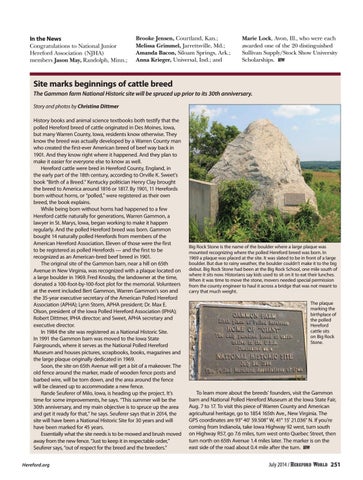In the News Congratulations to National Junior Hereford Association (NJHA) members Jason May, Randolph, Minn.;
Brooke Jensen, Courtland, Kan.; Melissa Grimmel, Jarrettsville, Md.; Amanda Bacon, Siloam Springs, Ark.; Anna Krieger, Universal, Ind.; and
Marie Lock, Avon, Ill., who were each awarded one of the 20 distinguished Sullivan Supply/Stock Show University Scholarships. HW
Site marks beginnings of cattle breed The Gammon farm National Historic site will be spruced up prior to its 30th anniversary. Story and photos by Christina Dittmer History books and animal science textbooks both testify that the polled Hereford breed of cattle originated in Des Moines, Iowa, but many Warren County, Iowa, residents know otherwise. They know the breed was actually developed by a Warren County man who created the first-ever American breed of beef way back in 1901. And they know right where it happened. And they plan to make it easier for everyone else to know as well. Hereford cattle were bred in Hereford County, England, in the early part of the 18th century, according to Orville K. Sweet’s book “Birth of a Breed.” Kentucky politician Henry Clay brought the breed to America around 1816 or 1817. By 1901, 11 Herefords born without horns, or “polled,” were registered as their own breed, the book explains. While being born without horns had happened to a few Hereford cattle naturally for generations, Warren Gammon, a lawyer in St. Marys, Iowa, began working to make it happen regularly. And the polled Hereford breed was born. Gammon bought 14 naturally polled Herefords from members of the American Hereford Association. Eleven of those were the first to be registered as polled Herefords — and the first to be recognized as an American-bred beef breed in 1901. The original site of the Gammon barn, near a hill on 65th Avenue in New Virginia, was recognized with a plaque located on a large boulder in 1969. Fred Knosby, the landowner at the time, donated a 100-foot-by-100-foot plot for the memorial. Volunteers at the event included Bert Gammon, Warren Gammon’s son and the 35-year executive secretary of the American Polled Hereford Association (APHA); Lynn Storm, APHA president; Dr. Max E. Olson, president of the Iowa Polled Hereford Association (IPHA); Robert Dittmer, IPHA director; and Sweet, APHA secretary and executive director. In 1984 the site was registered as a National Historic Site. In 1991 the Gammon barn was moved to the Iowa State Fairgrounds, where it serves as the National Polled Hereford Museum and houses pictures, scrapbooks, books, magazines and the large plaque originally dedicated in 1969. Soon, the site on 65th Avenue will get a bit of a makeover. The old fence around the marker, made of wooden fence posts and barbed wire, will be torn down, and the area around the fence will be cleaned up to accommodate a new fence. Rande Seuferer of Milo, Iowa, is heading up the project. It’s time for some improvements, he says. “This summer will be the 30th anniversary, and my main objective is to spruce up the area and get it ready for that,” he says. Seuferer says that in 2014, the site will have been a National Historic Site for 30 years and will have been marked for 45 years. Essentially what the site needs is to be mowed and brush moved away from the new fence. “Just to keep it in respectable order,” Seuferer says, “out of respect for the breed and the breeders.” Hereford.org
Big Rock Stone is the name of the boulder where a large plaque was mounted recognizing where the polled Hereford breed was born. In 1969 a plaque was placed at the site. It was slated to be in front of a large boulder. But due to rainy weather, the boulder couldn’t make it to the big debut. Big Rock Stone had been at the Big Rock School, one mile south of where it sits now. Historians say kids used to sit on it to eat their lunches. When it was time to move the stone, movers needed special permission from the county engineer to haul it across a bridge that was not meant to carry that much weight. The plaque marking the birthplace of the polled Hereford cattle sits on Big Rock Stone.
To learn more about the breeds’ founders, visit the Gammon barn and National Polled Hereford Museum at the Iowa State Fair, Aug. 7 to 17. To visit this piece of Warren County and American agricultural heritage, go to 1854 165th Ave., New Virginia. The GPS coordinates are 93° 40' 59.508" W, 41° 15' 21.036" N. If you’re coming from Indianola, take Iowa Highway 92 west, turn south on Highway R57, go 7.6 miles, turn west onto Quebec Street, then turn north on 65th Avenue 1.4 miles later. The marker is on the east side of the road about 0.4 mile after the turn. HW
July 2014 /
251
